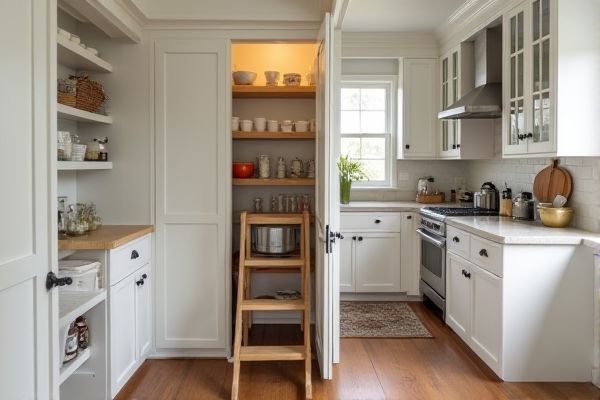
A rolling ladder offers greater reach and stability for accessing high pantry shelves, while a step stool provides portability and compact storage for quick, lower-reach tasks. Explore the full article to determine which option best suits your pantry access needs and complements Your space.
Table of Comparison
| Feature | Rolling Ladder | Step Stool |
|---|---|---|
| Mobility | High - Smooth rolling on floor | Low - Manual repositioning required |
| Height Reach | 6 to 8 feet or more | 1 to 3 feet |
| Storage Space | Requires more floor space | Compact and easy to store |
| Safety | Stable with rails, less risk of slipping | Riskier without handrails or anti-slip features |
| Ease of Use | Requires installation, smooth access | No installation, quick to use |
| Best For | Tall pantry shelves or frequent use | Shorter shelves and occasional access |
| Cost | Higher initial investment | Low cost |
Introduction: Pantry Access Solutions
Rolling ladders offer enhanced reach and stability for accessing high pantry shelves, providing smooth mobility along a track system. Step stools are compact and lightweight, ideal for quick access to moderately elevated storage but may lack the support and convenience of rolling ladders. Choosing between the two depends on pantry height, frequency of use, and space constraints.
Rolling Ladder Overview
A rolling ladder provides stable, wide steps and smooth mobility, making it ideal for accessing high pantry shelves safely and efficiently. Its robust design supports your weight while allowing easy movement along a track, enhancing convenience in narrow or crowded kitchen spaces. Compared to step stools, rolling ladders offer greater reach and stability for frequent pantry access.
Step Stool Overview
Step stools provide a compact and lightweight solution for reaching high shelves in your pantry with ease and stability. Unlike rolling ladders, step stools are typically more portable and require less space for storage, making them ideal for small kitchens or quick access tasks. Their design emphasizes safety with wide treads and non-slip surfaces, enhancing your ability to access pantry items without risk.
Space Requirements: Rolling Ladder vs Step Stool
A rolling ladder requires more floor space due to its length and the need for clearance to move smoothly along tracks, making it suitable for wider pantry aisles or rooms with ample space. In contrast, a step stool is compact and easily stored, occupying minimal floor area, ideal for smaller pantries with limited space. Choosing between the two depends on available pantry dimensions and how much room can be dedicated to accessibility tools.
Safety and Stability Comparison
Rolling ladders offer superior stability with wider bases and railings, reducing the risk of slipping or falling when accessing high pantry shelves. Step stools provide portability and compactness but may lack the same level of safety, especially without handrails or non-slip treads. Your choice should prioritize stability features to ensure safe pantry access during everyday use.
Ease of Use and Mobility
A rolling ladder offers superior ease of use with its smooth-gliding wheels and sturdy handrails, providing stable support and effortless access to high pantry shelves. Step stools prioritize compactness and lightweight design, enabling quick mobility and easy storage but may sacrifice some stability and reach compared to rolling ladders. For frequent pantry access, rolling ladders combine stability with mobility, while step stools excel in convenience and portability for occasional use.
Installation and Storage Considerations
Rolling ladders require secure mounting to a sturdy wall or track system, making installation more complex and often permanent. Step stools, by contrast, need no installation and offer easy portability, allowing them to be stored in tight pantry spaces or under shelves when not in use. Space-saving design favors step stools when minimal storage footprint is essential, while rolling ladders demand dedicated clearance for movement and positioning.
Design and Aesthetic Impact
A rolling ladder offers a sleek, built-in aesthetic that enhances kitchen elegance and provides seamless access to high pantry shelves, while a step stool is often compact and minimal but can appear utilitarian and less integrated. The ladder's design can become a focal point with its sturdy rails and polished finish, complementing cabinetry and adding architectural interest. Your pantry space benefits from the ladder's combination of functionality and visual appeal, making it ideal for stylish, high-end kitchens.
Durability and Maintenance
Rolling ladders offer superior durability with sturdy hardwood or metal construction designed to withstand frequent use, making them ideal for heavy pantry access tasks. Step stools, often made from lighter materials like plastic or aluminum, require more frequent replacement due to wear and tear but are easier to clean and maintain. Your choice depends on balancing the need for long-lasting performance with straightforward upkeep in your pantry space.
Choosing the Right Option for Your Pantry
Choosing between a rolling ladder and a step stool for pantry access depends on space, frequency of use, and safety requirements. Rolling ladders offer increased stability and ease of movement for taller or larger pantries, enhancing accessibility and ergonomic support. Step stools provide a compact, cost-effective solution ideal for smaller spaces and occasional use, though they may lack the reach and convenience of rolling ladders.
 homyna.com
homyna.com